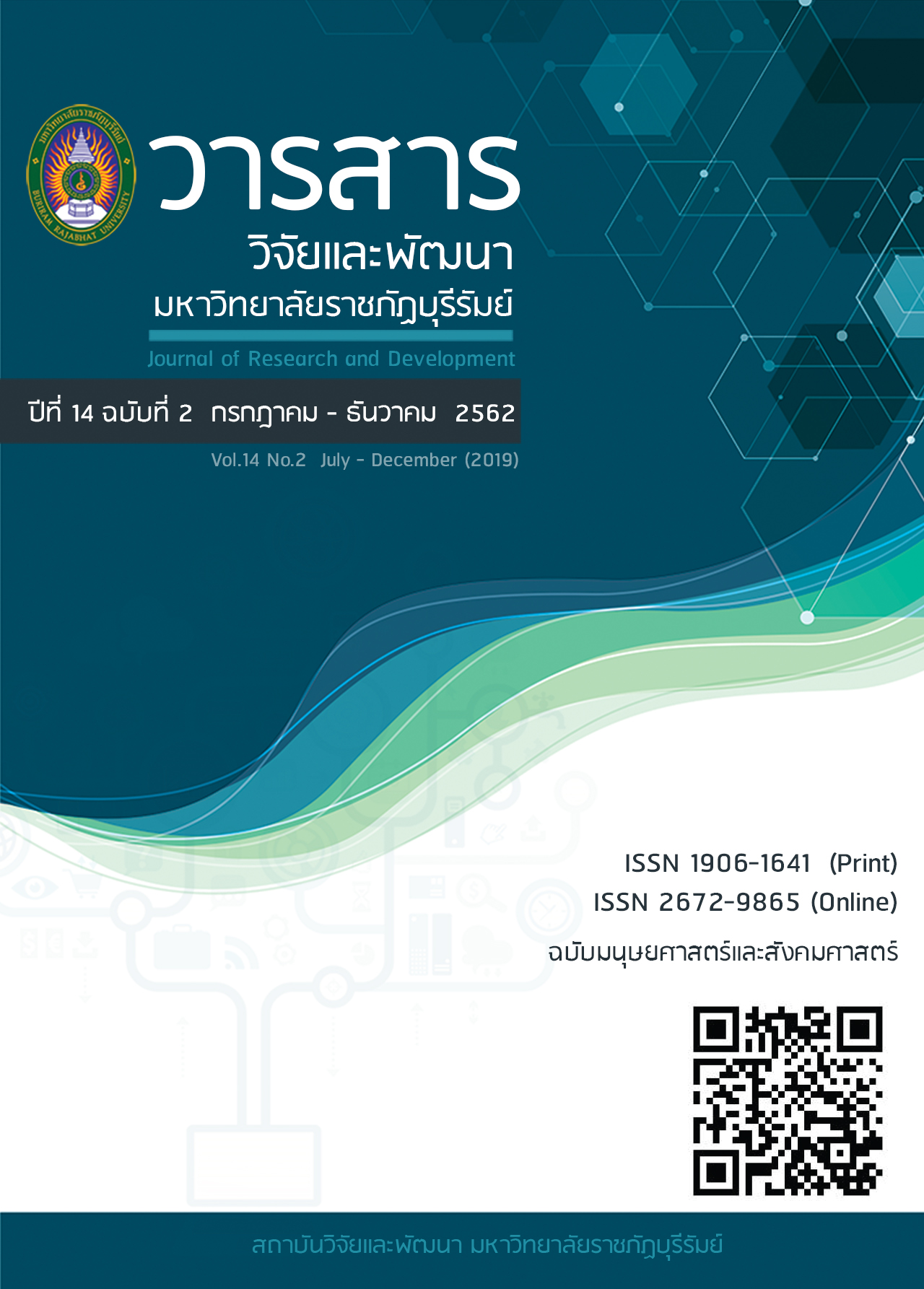Guidelines for Developing the Capacity to Create Product Identity for Sustainable Strengthening of Indigo Dyed Cotton Weaving Group in Baan Phonkoe Thakon Sub-district, Akat Amnuai District, Sakon Nakon Province
Main Article Content
Abstract
This research was a participatory action research (Participatory Action Research : PAR). This research was a local study (Community - Based Research : CBR) which aimed to study the context of Indigo dyed cotton weaving group in Baan Phonkoe, to study the capacity to create a unique of product of Indigo dyed cotton weaving group in Baan Phonkoe and to study the guidelines for developing the capacity to create a unique of product for sustainable strengthening of Indigo dyed cotton weaving group in Baan Phonkoe, Thakon Sub-District, Akat Amnuai District, Sakon Nakon Province. The data was collected from 20 participants of Indigo dyed cotton weaving community enterprise group from Baan Phonkoe, Thakon Sub-district, Akat Amnuai District, Sakon Nakon Province. The samples were selected from a specific selection of indigo dyed weaving group, with a total of 20 members and the tools used for data collection were group discussion, observation and interview.
The results revealed that : 1) the context of Indigo dyed cotton weaving group in Baan Phonkoe, there were 15 groups of organizations in the community which consisted of cremation assist group, health promotion temple, sufficiency agriculture group which related to reducing expenses, increasing income as a source of learning, self-sufficient agriculture, reduce expenses, increase income of the community, savings group for production, Million Fund Group, Poverty Alleviation Fund, Non-Formal Education Center (NFE), Mother Fund Group, dishwashing liquid production group, Indigo dyed cotton weaving group, plastic basket weaving group, cassava growing group, rubber growing group, Bio-organic fertilizer production group (fermented water) and Village Health Volunteers Group (VHV.). There were 4 groups of self-management on sufficiency economy model consisted of community waste management, drug problem management group in the village, temple activities evening pray with priests, and village cremation assist fund, and creation and development of six community innovations: dishwashing liquid production group, composting group, Bio-fermented water (Fermented pork excrement), mushroom cultivation group, pig fermented food production group, Indigo dyed cotton weaving group, and plastic basket weaving group. 2) The capacity to create product identity of Indigo dyed cotton weaving group in Baan Phonkoe was presented that Indigo dyed cotton weaving group was a career source for income of the households and community which were divided as 2.1) The development of unique product in group had revealed that the group had a need to create their own product identity, in order to create product identity, one must have the participation of co-thinking, co-expression, and practice, and must be unique from the history of the village. In the process of identity development, all members had been thinking together and told the story of the village, Baan Phonkoe. So the identity that is to be woven into the fabric must be important and consistent with the name of the village. In addition to innovate, to find out the identity of the group, the members also had the same name for the design to be named by writing the name of design that will be used to call the fabric to be woven into the identity of the group, the members had summarized the name of the fabric “Lai Mark Khoe” which was derived from the name of the village and 2.2) Membership development had been found to have a high capacity for weaving and the members had processed fabric from traditional woven scarves and shawls to sew blouses and skirts in order to add value and market to the product but the woven fabric was mostly the same pattern that the general community wove, so the group had a common opinion to develop a new fabric by the stage from 18 to 19 May 2017. As a result, the community had invented the fabric of the history of the community which was called “Lai Mark Khoe”. The researcher had collaborated with the community to design and let members of the group created Mudmee “Lai Mark Khoe” for weaving and 3) Guidelines for developing the capacity to create product identity for sustainable strengthening of Indigo dyed cotton weaving group in Baan Phonkoe was presented that guidelines for developing the community capacity consisted of 3.1) Contextual study of the community to create identity. 3.2) Set the stage for the real needs of the community participation process. 3.3) The decision to choose a model to create product identity. 3.4) Apply the selected model to create the model example and 3.5) Identity development by modeling the samples into woven cloth and 3.6) Application for design patent “Lai Mark Khoe.”
Article Details
เนื่อหาและข้อมูลในบทความ เป็นความรับผิดชอบของผุ้แต่ง
บทความในวารสารเป็นลิขสิทธิ์ของวารสารวิจัยและพัฒนา มหาวิทยาลัยราชภัฏบุรีรัมย์
References
การประชุมหาดใหญ่วิชาการระดับชาติและนานาชาติครั้งที่ 7 เมื่อวันที่ 23 มิถุนายน 2559 มหาวิทยาลัย
หาดใหญ่. 7 : 1326 - 1336.
ตรีวิทย์ แพทย์เพียร. (2557). “การออกแบบสัญลักษณ์แสดงเอกลักษณ์องค์กรสำหรับศูนย์วัฒนธรรมไทยทรงดำ ตำบลเขาย้อย
จังหวัดเพชรบุรี.” วารสารมนุษยสังคมปริทัศน์. ประจำเดือนมกราคม - มิถุนายน 2557. 16(1) : 1 - 14.
พิมพ์ลภัทร ศรีมณฑา และพัชร พิลึก. (2554). ภาพลักษณ์ตราสินค้าหนึ่งตำบลหนึ่งผลิตภัณฑ์ในเขตจังหวัดนนทบุรี.
รายงานการวิจัย. นนทบุรี. วิทยาลัยราชพฤกษ์.
พิสมัย อาวะกุลพาณิชย์ และคนธาภรณ์ เมียร์แมน. (2555). การเพิ่มมูลค่าและเอกลักษณ์ของผลิตภัณฑ์ล้านนาด้วย
การออกแบบโดยใช้ภูมิปัญญาท้องถิ่นล้านนา. รายงานการวิจัย คณะวิจิตรศิลป์. เชียงใหม่ :
มหาวิทยาลัยเชียงใหม่.
ไพบูลย์ บูรณสันติ. (2559). การพัฒนาศักยภาพและส่งเสริมเครือข่ายวิสาหกิจชุมชนเพื่อการพัฒนาสินค้าและบริการ
ด้านการท่องเที่ยว กลุ่มจังหวัดภาคใต้ฝั่งอันดามันอย่างยั่งยืน. แผนปฏิบัติราชการประจำปีของกลุ่มจังหวัด
พ.ศ.2559 กลุ่มจังหวัดภาคใต้ฝั่งอันดามัน (ระนอง พังงา ภูเก็ต กระบี่ และตรัง). ตรัง : สำนักงานพัฒนาชุมชน
จังหวัดตรัง.
สำนักงานคณะกรรมการพัฒนาเศรษฐกิจและสังคมแห่งชาติ. (2558). แผนพัฒนาเศรษฐกิจและสังคมแห่งชาติฉบับที่ 12
(พ.ศ. 2560-2564). กรุงเทพฯ : สำนักนายกรัฐมนตรี.
สุพรรณ สมไทย และคณะ. (2550). การออกแบบผลิตภัณฑ์ของตกแต่งบ้านโดยแนวคิดจากวัฒนธรรมชาวไทยทรงดำ.
รายงานการวิจัย คณะวิทยาศาสตร์และเทคโนโลยี. กรุงเทพฯ : มหาวิทยาลัยราชภัฏสวนดุสิต.
สุวนาถ ทองสองยอด. (2560). “ภาพลักษณ์ตราผลิตภัณฑ์โอทอป (OTOP) จังหวัดปัตตานี.” วารสารวิทยบริการ
มหาวิทยาลัยสงขลานครินทร์. มกราคม-เมษายน 2560. 28(1) : 14 - 24.
อริณ เมืองสมบัติ. (2554). “ความสำเร็จในการบริหารจัดการอาชีพกลุ่มอาชีพทำผ้าบาติกเทศบาล ตำบลหนองจอก.”
Local Administration Journal. ประจำเดือน เมษายน-มิถุนายน 2554. 4(2) : 30 - 42.

